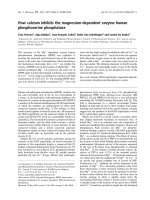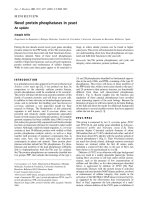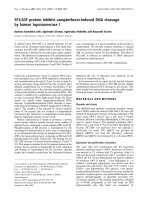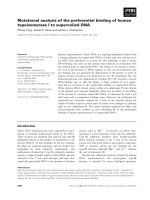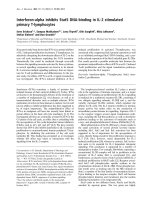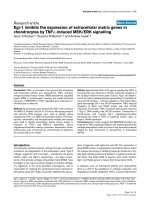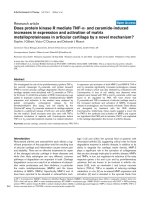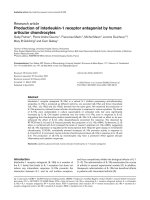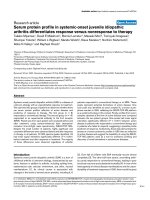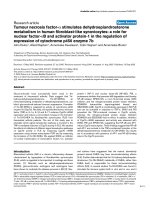Báo cáo Y học: SF2/ASF protein inhibits camptothecin-induced DNA cleavage by human topoisomerase I potx
Bạn đang xem bản rút gọn của tài liệu. Xem và tải ngay bản đầy đủ của tài liệu tại đây (180.76 KB, 7 trang )
SF2/ASF protein inhibits camptothecin-induced DNA cleavage
by human topoisomerase I
Barbara Kowalska-Loth, Agnieszka Girstun, Agnieszka Piekiełko and Krzysztof Staron
´
Institute of Biochemistry, Warsaw University, Warsaw, Poland
A splicing factor SF2/ASF is a natural substrate for the
kinase activity of human topoisomerase I. This study dem-
onstrates that SF2/ASF inhibits DNA cleavage by human
topoisomerase I induced by the anti-cancer agent campto-
thecin. The inhibition is independent of the phosphorylation
status of SF2/ASF. We show that the inhibition did not
result from binding of SF2/ASF to DNA that would hinder
interactions between topoisomerase I and DNA. Neither it
was a consequence of a loss of sensitivity of the enzyme to
camptothecin. We provide evidence pointing to reduced
formation of the cleavable complex in the presence of SF2/
ASF as a primary reason for the inhibition. This effect of
SF2/ASF is reflected by inhibition of DNA relaxation
catalysed by topoisomerase I.
Keywords: topoisomerase I; SF2/ASF; camptothecin.
Eukaryotic topoisomerase I (topo I) catalyses DNA relax-
ation and plays a key role in DNA replication, transcription
and recombination in the cell [1]. Topo I is also a target for
several anti-cancer drugs derived from the cytotoxic plant
alkaloid camptothecin [2]. A transient intermediate of the
enzyme’s catalytic cycle is the cleavable complex, consisting
of the enzyme linked covalently to one strand of DNA. This
complex is stabilized by camptothecin and can be detected
as topo I-associated DNA single-strand breaks [3]. These
breaks are usually called camptothecin-induced DNA
cleavage. Camptothecin-induced DNA cleavage is essen-
tially reduced by binding of SV40 T antigen [4] or ATP [5] to
topo I. The complex is not detected for several mutated
forms of the enzyme that are resistant to camptothecin
(reviewed in [6]). Sensitivity to camptothecin is also dimini-
shed by dephosphorylation of topo I [7,8].
Human topoisomerase I (htopo I) possesses a protein
kinase activity which is specific towards serine residues of
splicing factors containing a serine-arginine (SR) motif [9].
Phosphorylation of SR proteins is instrumental for the
recruitment of these proteins to active sites of transcription
in vivo [10] and for their activity as splicing factors [11]. SF2/
ASF is the main splicing factor containing an SR motif [12]
phosphorylated by htopo I/kinase [9]. The binding site for
SF2/ASF in htopo I is located between residues 135 and 175
[13]. This region is included in the N-terminal domain of the
enzyme that in general is dispensable for both relaxation
and binding of camptothecin [14,15]. However, detailed
studies have recently revealed that the N-terminal domain
influences the rate of relaxation and sensitivity of the
enzyme to camptothecin [16].
In the present work we report that the natural substrate
for the kinase activity of htopo I, SF2/ASF protein, inhibits
camptothecin-induced DNA cleavage by the enzyme. This
effect results from reduced amount of the cleavable complex
formed by htopo I in the presence of SF2/ASF.
MATERIALS AND METHODS
Plasmids and strains
The pRS426-based plasmid, containing complete human
topo I cDNA under the control of the GAL1-10, was a gift
from B. R. Knudsen (University of Aarhus, Denmark). The
yeast strain EKY3 (Dtop1)wasagiftfromJ.Fertala
(Thomas Jefferson University, Philadelphia, USA) and was
used to express htopo I. The plasmid containing ASF-1
cDNA was a gift from J. Tazi (Universite
´
Montpellier II,
France). SF2/ASF was expressed from this plasmid in
Escherichia coli strain TG1. pQE32 was provided by
Qiagen. pBR322 was from the laboratory collection.
pBR322 and pQE32 were produced in E. coli strain DH5a.
Expression and purification of proteins
The yeast cells were transformed with the expression
plasmid containing htopo I cDNA. Expression of htopo I
was induced in 2-L cultures with 2% galactose. After 4 h
cells were harvested, washed once with 1
M
sorbitol, 25 m
M
EDTA, pH 8.0, 50 m
M
dithiothreitol and lysed by addition
of zymolyase 100T (5 mgÆmL
)1
; from Seikagaku) in 1
M
sorbitol. Centrifuged spheroplasts were frozen and then
extracted twice with 20 m
M
Tris, pH 7.5, 0.5
M
KCl, 1 m
M
EDTA, 1 m
M
dithiothreitol, 10% glycerol, 1 m
M
phenyl-
methanesulfonyl fluoride. The extracts were then purified by
successive heparin-agarose and nickel-nitrilotriacetic acid-
agarose chromatography, as described previously [17].
Coomassie staining of the purified preparation indicated
an 91-kDa polypeptide as the only band on SDS
polyacrylamide gels. The band was recognized by
Correspondence to K. Staron
´
, Institute of Biochemistry, Warsaw
University, ul. Miecznikowa 1, 02–096 Warszawa, Poland.
Fax: + 48 225543116, Tel.: + 48 225543114,
E-mail:
Abbreviations: topo I, topoisomerase I; htopo I, human
topoisomerase I.
Enzymes: DNA topoisomerase I (EC 5.99.1.2).
(Received 18 February 2002, revised 20 May 2002,
accepted 31 May 2002)
Eur. J. Biochem. 269, 3504–3510 (2002) Ó FEBS 2002 doi:10.1046/j.1432-1033.2002.03037.x
scleroderma antibody to human topo I (TopoGEN).
Relaxing activity of the enzyme was 6.1 · 10
6
±2.2· 10
6
(n ¼ 4) units per mg protein. Htopo I was also active as a
protein kinase and selectively phosphorylated the SF2/ASF
substrate. The htopo I preparations were adjusted to 20%
glycerol and stored at )80 °C.
Bacteria transformed with the expression vector for
SF2/ASF were grown in 100 mL cultures. Expression of
the protein was induced by 1 m
M
isopropyl thio-b-
D
-galactoside for 1 h. SF2/ASF was isolated and purified
as described previously [9] and stored at )80 °C. Directly
before each experiment, SF2/ASF was centrifuged to
remove aggregates. The phosphorylated form of SF2/ASF
was produced by the in vitro phosphorylation of isolated
SF2/ASF and then was directly used in the cleavage assay.
To phosphorylate SF2/ASF, htopo I and unlabeled 1 m
M
ATP were used under the conditions of the kinase assay
[9]. When the mixture was further used in the cleavage
assay, it was diluted so that concentration of ATP was
150 l
M
. At this concentration, ATP did not influence
DNA cleavage (not shown). Based on analysis of the
htopo I-catalysed incorporation of the label from
[c-
32
P]ATP to samples of SF2/ASF previously either
phosphorylated or subjected to the mock procedure, we
calculated that 87% of the accessible sites were phos-
phorylated in the preparation used in the cleavage assay as
Ôphosphorylated SF2/ASFÕ.
The amount of htopo I and SF2/ASF was quantified by
densitometric scanning of SDS-polyacrylamide gels using
BSA as a standard.
DNA cleavage assay
Routinely, the DNA substrate labelled at its 3¢ end was used
in the cleavage assay. The 505-bp DNA fragment was
prepared from pQE32 vector (Qiagen). The vector DNA
was cleaved with EcoRI and labeled using [a-
32
P] ATP
(3000 CiÆmmol
)1
; Amersham) and T7 sequenase (Amer-
sham) according to the manufacturer’s protocol. The DNA
sample was then cleaved with DraIandthefragmentof
505 bp was purified by an agarose gel electrophoresis. When
indicated, DNA labelled at 5¢ end was used. The 653-bp
fragment was prepared from pBR322 plasmid cleaved with
EcoRI and SalI. The EcoRI–SalI fragment was purified by
agarose electrophoresis, dephosphorylated by calf intestinal
alkaline phosphatase (USB) and labeled using T4 polynu-
cleotide kinase and [c-
32
P]ATP (5000 CiÆmmol
)1
,Amer-
sham) [18].
The cleavage reaction was performed with 0.15–2.5 ng of
labeled DNA substrate and an appropriate amount of
htopo I in the buffer containing 50 m
M
KCl, 10 m
M
MgCl
2
,0.1m
M
EDTA, 50 lgÆmL
)1
gelatin, 20 m
M
Tris,
pH 7.5 and various amounts of SF2/ASF. When indicated,
1 lL of camptothecin dissolved in dimethylsulfoxide was in
the final reaction volume 100 lL. The mixtures were
incubated for 30 min at 30 °C. The reaction was stopped
by addition of 12 lL of 10% SDS and samples were
incubated for 15 min at 75 °C, chilled and digested for 1 h
at 37 °C with proteinase K. When indicated, the protein
digestion step was omitted but instead 1 m
M
phenyl-
methanesulfonyl fluoride was added. A carrier DNA was
added before ethanol precipitation. The DNA samples
were dissolved in 10 m
M
Tris containing 25% formamide,
heated to 75 °C for 4 min and analysed using 7.5%
polyacrylamide/7
M
urea gels. Gels were exposed for 24 h
using Rentgen XS-1 (Foton) or Biomax MS (Kodak) films.
Mobility shift assay
The mobility shift assay was performed using a 377-bp
EcoRI–BamHI fragment of pBR322, labelled at the 3¢ end
as described above. Purified proteins were incubated with
1.69 fmol DNA in 40 m
M
Tris/acetate, 1 m
M
EDTA,
pH 8.0. The DNA and DNA–protein complexes were run
on 6% native polyacrylamide gel for 1 h at 200 V. Gels
were exposed for 24 h using Rentgen XS-1 (Foton).
Relaxation assay
DNA relaxation activity of htopo I was measured using
supercoiled pBR322 plasmid DNA as a substrate. Reaction
mixtures (10 lL final volume) contained 0.2–0.4 lg plasmid
DNA, 120 m
M
KCl, 10 m
M
MgCl
2
,0.1m
M
EDTA, 10 m
M
2-mercaptoethanol, 100 lgÆmL
)1
BSA, 40 m
M
Tris/HCl,
pH 7.5 and various amounts of htopo I protein. When
indicated, the mixtures contained various amounts of SF2/
ASF. Reaction was performed either at 30 °C(forestima-
tion of specific activity of htopo I) or at 0 °Candwas
terminated by addition of 5 lL of the stop buffer (27%
sucrose, 0.67% SDS, 67 m
M
EDTA, pH 8, Orange G). The
samples were loaded onto a 1% agarose gel and subjected to
electrophoresis for 1.5 h at 100 V. Gels were stained with
ethidium bromide and the reaction was quantified by
densitometric scanning of negatives of photographed elec-
trophoretic gels. Relaxation activity was calculated from
decrease of the amount of supercoiled DNA. One unit
relaxed 50% of the substrate DNA after 30 min at 30 °C.
Kinase assay
Htopo I kinase activity was measured using SF2/ASF and
[c-
32
P]ATP (5000 CiÆmmol
)1
; Amersham) as substrates,
under conditions described previously [9]. The proteins were
analysed using 12% SDS/polyacrylamide gels, dried and
exposed for 24 h using Rentgen XS-1 (Foton) films.
RESULTS
Inhibition of the DNA cleavage by SF2/ASF
To study camptothecin-induced DNA cleavage by htopo I
we routinely used the EcoRI–DraI fragment of pQE32
DNA labelled at the 3¢ end. The cleavage was visible at the
concentration of camptothecin as low as 1 l
M
. However, to
study effects of SF2/ASF on the cleavage we used camp-
tothecin concentration of 100 l
M
(Fig. 1). This was to avoid
a possibility of lowered drug-sensitivity for the enzyme
remaining in the complex with SF2/ASF. Such an effect,
appearing as an elevated concentration of camptothecin
needed to induce DNA cleavage, has been previously
observed for some point mutations in htopo I [19].
We examined dependence of the inhibition of DNA
cleavage on the amount of SF2/ASF present in the reaction
mixture. We performed the cleavage assay with a fixed
amount of htopo I and various amounts of SF2/ASF. An
example of such an experiment is shown in Fig. 2.
Ó FEBS 2002 SF2/ASF and effect of camptothecin (Eur. J. Biochem. 269) 3505
Approximately 50% inhibition of the cleavage was achieved
at the htopo I: SF2/ASF ratio of 1.79 ± 0.76 (± SD,
n ¼ 8).
The recombinant SF2/ASF protein used in the experi-
ments described above remained unphosphorylated within
its SR motif recognized by htopo I [13]. To investigate the
effect of phosphorylation of SF2/ASF, we used SF2/ASF
previously phosphorylated by htopo I. We found that
phosphorylated SF2/ASF inhibited DNA cleavage
1
to the
same extent as the unphosphorylated protein (not shown).
Looking for a possible reason for inhibition of campto-
thecin-induced DNA cleavage by SF2/ASF we considered
three possibilities. (a) The effect of SF2/ASF results not
from its interaction with htopo I but from its binding to
DNA. (b) SF2/ASF decreases the sensitivity of htopo I to
camptothecin. (c) SF2/ASF inhibits the formation of the
cleavable complex by htopo I in the absence of camptothe-
cin. These possibilities were successively examined in the
further work.
Accessibility of DNA for htopo I
Unphosphorylated, recombinant SF2/ASF is a basic pro-
tein and is known to bind nucleic acids nonspecifically [20].
Thus, a trivial explanation for the inhibition of the DNA
cleavage could be that SF2/ASF preferentially bound to
DNA and prevented htopo I from contacting with the
substrate. To check this possibility we performed two sets of
experiments. The first one was to indicate whether htopo I
or SF2/ASF binds to DNA more effectively. The other was
to check whether SF2/ASF blocked accessibility of htopo I
to DNA.
To follow binding of proteins to DNA we employed a
mobility shift assay (Fig. 3). Under these conditions, a
portion of DNA was shifted towards slower migrating band
if 0.14 pmol of htopo I was present in the sample (Fig. 3A).
At higher amounts of htopo I (0.28 pmol), all DNA present
in the sample aggregated and did not penetrate into the gel
(Fig. 3B, lane 2). The mobility shift did not indicate DNA–
protein complexes for SF2/ASF protein. Instead, we
observed aggregation of DNA (Fig. 3B, lane 5). An amount
of SF2/ASF at which the aggregation occurred (1.58 pmol)
was more than five times higher than that needed for the
same effect caused by htopo I. Because an effective
inhibition of camptothecin-induced DNA cleavage was
observed at an twofold excess of SF2/ASF over htopo I
(Fig. 2), the mobility shift experiments excluded a possibility
that the inhibition resulted from removal of DNA aggre-
gated by SF2/ASF. However, these experiments alone did
not give answer to the question whether SF2/ASF can block
accessibility of htopo I to DNA.
To check accessibility of DNA to proteins in the presence
of htopo I, SF2/ASF and both proteins we employed
restriction nucleases as reference probes. To exclude any
specific interaction between the endonuclease and examined
proteins we used three different restriction endonucleases:
HindIII, RsaIandSphI, observing the same pattern of
digestion in each case. Results obtained with HindIII and
RsaI are presented in Fig. 4. Each of the restriction
endonucleases employed in the assay cut the substrate (the
EcoRI–DraI fragment of pQE32 DNA) only once. Diges-
tion with endonucleases was performed under conditions of
the cleavage assay in the presence of camptothecin. Such an
Fig. 2. Dependence of the inhibition on SF2/ASF concentration. 3¢-
Labelled DNA fragment was a substrate. The concentration of
camptothecin was 100 l
M
; 0.65 pmol htopo I and various amounts of
SF2/ASF were used. Lane 1, DNA alone; lane 2, htopo I; lanes 3–8,
htopo I + SF2/ASF. Amounts of SF2/ASF were: lane 3, 0.2 pmol;
lane 4, 0.4 pmol; lane 5, 0.8 pmol; lane 6, 2 pmol; lane 7, 4 pmol;
lane 8, 8 pmol.
Fig. 1. Inhibition of camptothecin-induced cleavage by SF2/ASF.
3¢-Labelled DNA fragment was a substrate. The concentration of
camptothecin was 100 l
M
;0.35pmolhtopoIand0.8pmolSF2/ASF
wereused.Lanes:1,DNAalone;2,DNA+camptothecin;
3,DNA+htopoI;4,DNA+htopoI+camptothecin;5,DNA+
htopo I+ SF2/ASF; 6, DNA +htopo I +camptothecin +SF2/ASF.
3506 B. Kowalska-Loth et al. (Eur. J. Biochem. 269) Ó FEBS 2002
approach had an advantage of assuring that the amount of
htopo I used in the test was big enough to cleave DNA and
the concentration of SF2/ASF was high enough to inhibit
htopo I-catalysed cleavage. In this case, the rate of compe-
tition between endonucleases and htopo I was not clear
because DNA fragments produced by the endonucleases
were further cleaved by htopo I (Fig. 4, lanes 2 and 6).
However, it is clearly visible that SF2/ASF only slightly
inhibited the cutting of DNA by either HindIII or RsaI. At
thesameconcentrationofSF2/ASFinthepresenceof
htopo I, both endonucleases cut DNA less efficiently than
in the presence of SF2/ASF alone (compare lanes 3 and 4 or
7 and 8) indicating that SF2/ASF did not block accessibility
of htopo I to DNA.
Sensitivity of the kinase reaction of htopo I
to camptothecin
Another explanation for the inhibition of DNA cleavage by
SF2/ASF would be lack of binding of camptothecin to
existing cleavable complex. This, however, was not a case
because htopo I remained sensitive to camptothecin in the
presence of SF2/ASF. We examined it for the kinase
reaction that used SF2/ASF as a substrate. Under condi-
tions of this reaction SF2/ASF was present in the eightfold
excess over htopo I.
Addition of increasing amounts of DNA to the reaction
mixture resulted in a gradual decrease and eventually a
complete inhibition of phosphorylation of SF2/ASF by
htopo I (Fig. 5A). If small amount of DNA was present in
the reaction mixture (0.15 fmol pBR322 DNA), the inhibi-
tion of the kinase reaction by DNA was significantly
enhanced upon subsequent addition of camptothecin
(Fig. 5B).
DNA relaxation by htopo I performed in the presence of
SF2/ASF remained sensitive to camptothecin (not shown).
Inhibition of formation of the cleavable complex
by SF2/ASF in the absence of camptothecin
A likely explanation for the inhibition of DNA cleavage is
that SF2/ASF directly influenced the reaction catalysed by
htopo I so that a reduced amount of the covalent DNA–
htopo I complex was formed. To check this possibility we
performed the cleavage reaction without camptothecin.
Because of the low efficiency of the cleavage occurring in the
absence of camptothecin we used the substrate labelled at its
5¢ end that allowed us to distinguish accidental DNA breaks
from those introduced by htopo I. The product of the
cleavage of the 5¢-labelled substrate by htopo I would be the
enzyme covalently bound to the labelled strand. Such a
cleavage product would enter gel only after prior digestion
Fig. 3. Binding of htopo I and SF2/ASF to DNA revealed by mobility
shift assay. (A) Binding of htopo I to DNA. Lanes: 1, DNA alone;
2, DNA + 0.14 pmol htopo I. (B) Aggregation of DNA by htopo I
and SF2/ASF. Lanes: 1, DNA alone; 2, DNA + 0.28 pmol htopo I;
3, DNA + 0.28 pmol SF2/ASF, 4, DNA + 0.56 pmol SF2/ASF,
5, DNA + 1.58 pmol SF2/ASF; 6, DNA + 0.28 pmol htopo I
+0.56 pmol SF2/ASF.
Fig. 4. Accessibility of DNA for restriction endonucleases in the pres-
ence of htopo I, SF2/ASF or both proteins. 3¢-Labelled DNA fragment
was a substrate. The concentration of camptothecin was 100 l
M
;
0.92 pmol htopo I, 0.92 pmol SF2/ASF, 10 U HindIII and 15 U RsaI
were used. The mixtures were incubated for 30 min at 30 °C. Lanes: 1,
HindIII; 2, HindIII + htopo I; 3, HindIII + SF2/ASF; 4, HindIII +
htopo I + SF2/ASF; 5, RsaI; 6, RsaI + htopo I; 7, RsaI+SF2/ASF;
8, RsaI + htopo I + SF2/ASF.
Ó FEBS 2002 SF2/ASF and effect of camptothecin (Eur. J. Biochem. 269) 3507
with proteinase that removed the bound protein [21].
Figure 6 shows the cleavage pattern for htopo I acting on
5¢-labelled DNA in the absence of camptothecin. Bands
absent in the undigested sample but appearing upon
digestion with proteinase K were identified as resulting
from htopo I cleavage. SF2/ASF abolished DNA cuts
introduced by htopo I in the absence of camptothecin. The
effect of SF2/ASF was specifically restricted to bands
coming from htopo I activity. This observation pointed to
smaller amount of covalent DNA–htopo I complex formed
in the presence of SF2/ASF as a primary reason for the
inhibition of camptothecin-induced DNA cleavage.
Effect of SF2/ASF on DNA relaxation
The question we wished to answer next was whether the
reduced amount of the cleavage complex formed in the
presence of SF2/ASF exerted any effect on DNA relaxation
by htopo I. At a high substrate DNA/topo I ratio, usually
used in relaxation tests, the release of the enzyme from DNA
is a rate-limiting step for relaxation [22]. On the other hand,
an impaired DNA cleavage observed in the cleavage assay
should be reflected by inhibition of the reaction catalysed by
htopo I rather than by inhibition of the movement of the
enzyme between DNA substrate molecules. Elimination of a
dissociation of htopo I as a rate-limiting step for relaxation
can be achieved by decreasing the DNA/htopo I ratio
during the relaxation to 1 : 1 or less [16]. However, in this
case the reaction rate should be slowed because of an
elevated amount of the enzyme [16]. We achieved this by
reducing the reaction temperature to 0 °C. The reaction rate
of relaxation was approximately 10–20 times lower at 0 °C
than at 30 °C. Low temperature did not impair binding of
SF2/ASF to htopo I because phosphorylation of this
protein by htopo I as well as inhibition of camptothecin-
induced DNA cleavage by SF2/ASF were still observed at
0 °C (not shown). Under conditions of the relaxation assay
SF2/ASF slowed the relaxation of DNA (Fig. 7).
Fig. 6. Inhibition of DNA cleavage by SF2/ASF in the absence
of camptothecin. 5¢-Labelled DNA fragment was a substrate.
0.32 pmol htopo I and 1.3 pmol SF2/ASF were used. Lanes: 1, DNA
alone; 2, htopo I, no proteinase K; 3, htopo I, digested with proteinase
K; 4, htopo I + SF2/ASF, no proteinase K; 5, htopo I + SF2/ASF,
digested with proteinase K.
Fig. 5. Inhibition of kinase activity of htopo I by DNA and campto-
thecin. htopo I (0.16 pmol) and SF2/ASF (1.25 pmol) were used. The
concentration of camptothecin was 100 l
M
; pBR322 DNA was used
to inhibit the reaction. The reaction was carried out for 8 min at 30 °C.
(A) Inhibition by DNA. Lanes: 1, no DNA; 2, 0.15 fmol DNA; 3,
1.5 fmol DNA; 4, 15 fmol DNA. (B) Effect of camptothecin at
0.15 fmol DNA. Lanes: 1, camptothecin, 2, DNA; 3, DNA +
camptothecin.
Fig. 7. Effect of SF2/ASF on relaxing activity at the equimolar ratio of
htopo I and DNA. 70 fmol pBR322 DNA, 71 fmol htopo I and
71 fmol SF2/ASF were used. The reaction was carried out at 0 °C.
Lanes: 1, DNA alone; upper gel, DNA + htopo I; lower gel, DNA +
htopo I + SF2/ASF. The reaction times were: lane 2, 15 s; lane 3,
30 s; lane 4, 1 min, lane 5, 2.5 min; lane 6, 5 min; lane 7, 10 min;
lane 8, 20 min.
3508 B. Kowalska-Loth et al. (Eur. J. Biochem. 269) Ó FEBS 2002
DISCUSSION
The results presented in this work show that the substrate
for the kinase activity of htopo I, SF2/ASF, inhibits the
camptothecin-induced DNA cleavage. Looking for a
primary reason for this phenomenon we considered: (a) a
direct effect of SF2/ASF on DNA, (b) loss of sensitivity to
camptothecin for htopo I, or (c) a direct effect of SF2/ASF
on the reaction catalysed by htopo I. We excluded first two
possibilities and provided evidence pointing to the latter
one.
Modulation of relaxing activity by a direct effect of ssb
proteins on DNA has been reported for bacterial topo I
[23]. We took into consideration the possibility that SF2/
ASF acted directly on DNA because it had previously been
reported to bind nonspecifically to nucleic acids [21]. SF2/
ASF could thus preferentially bind to DNA and prevent
this way DNA from cutting by htopo I. We excluded this
possibility showing that htopo I bound to DNA more
effectively than SF2/ASF and that SF2/ASF did not block
accessibility of htopo I to DNA.
A decrease in sensitivity to camptothecin has previously
been observed for several point mutations in htopo I [6].
However, it has also been shown that htopo I is sensitive to
camptothecin in the presence of the excess of SF2/ASF
because the drug inhibits the kinase reaction that uses SF2/
ASF as a substrate [9]. In this work we determined results
similar to [9]. They
2
ruled out the possibility that a reason for
camptothecin-induced DNA cleavage by SF2/ASF is a loss
in sensitivity of htopo I to camptothecin. The question that
still remains to be answered is why camptothecin inhibits the
kinase reaction if SF2/ASF essentially reduces the amount
of the cleavable complex formed in the presence of the drug.
A helpful indication could be the observation that inhibition
of the kinase reaction does not need camptothecin but is
achieved by immobilization of htopo I on DNA, either by
noncovalent binding or in the form of the cleavable
complex. One might thus speculate that, if SF2/ASF
inhibits the reaction catalysed by htopo I (see below),
stabilization of a rarely appearing cleavable complex by
camptothecin could shift the equilibrium between htopo I
engaged in phosphorylation and that bound to DNA
towards the latter pool.
Finally, we directly showed that SF2/ASF specifically
inhibits formation of the cleavable complex by htopo I in
the absence of camptothecin. A reason for this phenomenon
could be that either SF2/ASF prevents htopo I from
binding to DNA or it impairs the reaction catalysed by
the enzyme. The first mechanism has been revealed as
underlying the inhibition of camptothecin-induced DNA
cleavage by ATP [5]. On the other hand, a shorter half-time
for the cleavable complex eventually resulting in its reduced
amount, has been reported for reconstituted htopo I lacking
the linker region [14]. Inhibition of the kinase reaction by
DNA and competition experiments with endonucleases did
not suggest that SF2/ASF diminishes binding of htopo I to
DNA. Thus, a direct effect of SF2/ASF on the reaction
catalysed by htopo I is a more likely mechanism.
An inhibitory effect of SF2/ASF on camptothecin-
induced DNA cleavage was observed for both the unmodi-
fied and phosphorylated form of the protein. This
observation is consistent with findings showing that the
interaction of SF2/ASF with htopo I uses the RS domain of
this protein and that phosphorylation of this domain does
not impair the interaction [13].
A direct reason for cytotoxic effects of camptothecin is
stabilization of the cleavable complex, eventually leading to
DNA damage [24]. Because SF2/ASF is a natural substrate
for htopo I kinase activity [9], inhibition of the formation of
camptothecin-stabilized cleavable complex should be rele-
vant to the in vivo conditions. An clear conclusion is that
SF2/ASF might play a protective role against camptothe-
cin-induced DNA damage in transcriptionally active
regions of chromatin where the kinase activity of htopo I
is exploited.
A consequence of the reduced formation of the cleavable
complex in the presence of SF2/ASF is the slowing of DNA
relaxation. Such an effect was observed in this work for the
reaction performed at the equimolar ratio of htopo I and
the substrate DNA. It is consistent with effects of another
substrate of the kinase reaction, ATP, which disable htopo I
from binding to DNA [9]. It has been proposed that ATP
switches the activity of htopo I from DNA relaxation on
phosphorylation of SR proteins [9]. The results of this work
show that SF2/ASF could work in concert with ATP as an
inhibitor of DNA relaxation.
ACKNOWLEDGEMENTS
We wish to thank Dr Birgitte R. Knudsen from University of Aarhus,
Denmark, Dr Jamal Tazi from Universite
´
Montpellier II, France and
Dr Jolanta Fertala from Thomas Jefferson University, Philadelphia,
USA, for providing plasmids and the yeast strain. We thank Alicja
Czubaty for critical comments on the manuscript. This work was
supported by the State Committee for Scientific Research (KBN, grant
6 P04A 069 15).
REFERENCES
1. Wang, J.C. (1996) DNA topoisomerases. Annu. Rev. Biochem. 65,
635–692.
2. Rothenberg, M.L. (1997) Topoisomerase I inhibitors: review and
update. Ann. Oncol. 8, 837–855.
3. Hsiang, Y.H., Hertzberg, R., Hecht, S. & Liu, L.F. (1985)
Camptothecin induces protein-linked DNA breaks via mamma-
lian topoisomerase I. J. Biol. Chem. 260, 14873–14878.
4. Pommier, Y., Kohlhagen, G., Wu, C. & Simmonds, D.T. (1998)
Mammalian DNA topoisomerase I activity and poisoning by
camptothecin are inhibited by simian virus 40 large T antigen.
Biochemistry 37, 3818–3823.
5. Chen, H.J. & Hwang, J. (1999) Binding of ATP to human to-
poisomerase I resulting in an alteration of the conformation of the
enzyme. Eur. J. Biochem. 265, 367–375.
6. Pommier, Y., Pourquier, P., Fan, Y. & Strumberg, D. (1998)
Mechanism of action of eukaryotic DNA topoisomerase I and
drugs targeted to the enzyme. Biochim. Biophys. Acta 1400, 83–
106.
7. Pommier, Y., Kerrigan, D., Hartman, K.D. & Glazer, R.I. (1990)
Phosphorylation of mammalian DNA topoisomerase I and acti-
vation by protein kinase C. J. Biol. Chem. 265, 9418–9422.
8. Staron
´
, K., Kowalska-Loth, B., Za¸ bek, J., Czerwin
´
ski, R.M.,
Nieznan
´
ski, K. & Szumiel, I. (1995) Topoisomerase I is differently
phosphorylated in two sublines of L5178Y mouse lymphoma cells.
Biochim. Biophys. Acta 1260, 35–42.
9. Rossi, F., Labourier, E., Forne
´
, T., Divita, G., Derancourt, J.,
Riou, J.F., Antoine, E., Cathala, G., Brunel, C. & Tazi, J. (1996)
Specific phosphorylation of SR proteins by mammalian DNA
topoisomerase I. Nature 381, 80–82.
Ó FEBS 2002 SF2/ASF and effect of camptothecin (Eur. J. Biochem. 269) 3509
10. Misteli, T., Ca
´
ceres, J.F., Clement, J.Q., Krainer, A.R., Wilkin-
son, M.F. & Spector, D.L. (1998) Serine phosphorylation of SR
proteins is required for their recruitment to sites of transcription
in vivo. J. Cell Biol. 143, 297–307.
11. Koizumi, J., Okamoto, Y., Onogi, H., Mayeda, A., Krainer, A. &
Hagiwara, M. (1999) The subcellular localization of SF2/ASF is
regulated by direct interaction with SR protein kinases (SRPKs).
J. Biol. Chem. 274, 11125–11131.
12. Krainer, A.R., Mayeda, A., Kozak, D. & Binns, G. (1991)
Functional expression of cloned human splicing factor SF2:
homology to RNA-binding proteins, U1, 70K and Drosophila
regulators. Cell 66, 383–394.
13. Labourier, E., Rossi, F., Gallouzi, I., Allemend, E., Divita, G. &
Tazi, J. (1998) Interaction between the N-terminal domain of
human DNA topoisomerase I and the arginine-serine domain of
its substrates determines phosphorylation of SF2/ASF splicing
factor. Nucleic Acids Res. 26, 2955–2962.
14. Stewart, L., Ireton, G.C. & Champoux, J.J. (1999) A functional
linker in human topoisomerase I is required for maximum sensi-
tivity to camptothecin in a DNA relaxation assay. J. Biol. Chem.
274, 32950–32960.
15. Redinbo, M.R., Stewart, L., Kuhn, P., Champoux, J.J. & Hol,
W.G.J. (1998) Crystal structures of human topoisomerase I in
covalent and noncovalent complexes with DNA. Science 279,
1504–1513.
16. Lisby, M., Olesen, J.R., Skouboe, C., Krogh, B.O., Straub,
T.,Boege,F.,Velmurugan,S.,Martensen,P.M.,Andersen,
A.H., Jayaram, M., Westergaard, O. & Knudsen, B.R.
(2001) Residues within the N-terminal domain of human
topoisomerase I play a direct role in relaxation. J. Biol. Chem. 276,
20220–20227.
17. Kowalska-Loth, B., Bubko, I., Komorowska, B., Szumiel, I. &
Staron
´
, K. (1998) Contribution of topo I to conversion of single-
strand into double strand DNA breaks. Mol. Biol. Report 25,21–
26.
18. Sambrook, J., Fritsch, E.F. & Maniatis, T. (1989) Molecular
Cloning: a Laboratory Manual, Cold Spring Harbor Laboratory
Press, Cold Spring Harbor, NY.
19. Li,X G.,Haluska,P.,Hsiang,Y H.,Bharti,A.K.,Kufe,D.W.
& Rubin, E.H. (1997) Involvement of amino acids 361–364 of
human topoisomerase I in camptothecin resistance and enzyme
catalysis. Biochem. Pharmacol. 53, 1019–1027.
20. Tacke, R., Chen, Y. & Manley, J.L. (1997) Sequence-specific
RNA binding by an SR protein requires RS domain phospho-
rylation: Creation of an SRp40-specific splicing enhancer. Proc.
Natl Acad. Sci. USA 94, 1148–1153.
21. Bailly, C. (2001) DNA relaxation and cleavage assays to study
topoisomerase I inhibitors. Methods Enzymol. 340, 610–623.
22. Stivers, J.T., Shuman, S. & Mildvan, A.S. (1994) Vaccinia DNA
topoisomerase I: kinetic evidence for general acid-base catalysis
and a conformational step. Biochemistry 33, 15449–15458.
23. Skider, D., Unniraman, S., Bhaduri, T. & Nagaraja, V. (2001)
Functional cooperation between topoisomerase I and single
strand DNA-binding protein. J. Mol. Biol. 306, 669–679.
24. Jaxel, C., Taudou, G., Portemer, C., Mirambeau, G., Panijel, J. &
Duguet, M. (1998) Topoisomerase Inhibitors induce irreversible
fragmentation of replicated DNA in concanavalin A stimulated
splenocytes. Biochemistry 27, 95–99.
3510 B. Kowalska-Loth et al. (Eur. J. Biochem. 269) Ó FEBS 2002
